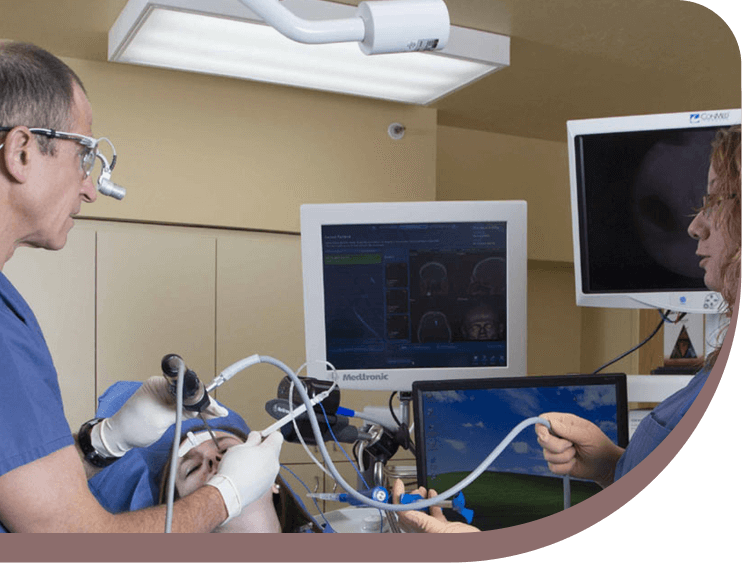
Balloon Sinuplasty
Balloon Sinuplasty can be performed in the ENT center’s office under local anesthesia because unlike traditional sinus surgery, balloon Sinuplasty requires no cutting nor removal of bone and tissue. BSP uses a small, flexible, balloon catheter to open up blocked sinus passageways and facilitate drainage of mucus that builds up in patients suffering from chronic sinusitis problems. This is done in our office using state-of-the-art image guided “Fusion” technology to verify placement and improve safety.
Balloon Sinuplasty – Benefits
Local Anesthesia: In-office Balloon Sinuplasty is an option for patients who want or need to avoid general anesthesia.
Fast Recovery: While recovery time varies with each patient, most patient who undergo the in-office procedure can return to normal activities and work within two days.
Comfortable Surroundings: Experience the procedure in the comfort of your physician’s office rather than a hospital operating room.
High Patient Satisfaction: The majority of patients who had Balloon Sinuplasty In-Office would recommend the procedure to family and friends.
Potential for Significant Cost Savings: Some eligible patients may have lower out of pocket costs if the procedure is performed in a lower cost of care setting, such as a physician’s office.

Balloon Sinuplasty – About
Sinus cavities that surround our eyes are normally filled with air when healthy. Secondary to allergies, sinus infection, or anatomical issues such as a deviated septum the natural sinus outflow tracts can become obstructed. The sinuses will become backed up with pressure and fluid and will produce many symptoms such as facial pressure, headache, congestion, fever, “brain fog”, fatigue, migraines, snoring, and cough.
Balloon Sinuplasty is a revolutionary office treatment for chronic and recurrent sinusitis. Typically performed under local anesthesia, the surgeon threads a small catheter through the sinus opening and then inflates the balloon with water, dilating the sinus opening to promote drainage and alleviate pain. Most patients return to work the next day, and say that the procedure is no more difficult than having a tooth repaired.
Balloon Sinuplasty – Diagnosis
Patients who suffer from sinus complaints such as: congestion, nasal blockage, post nasal drip, sinus pressure and headache, allergies, recurring sinus infections, chronic sinus infection should consider the procedure.
If you have exhausted medical management for sinusitis, you may be a candidate for balloon dilation. Balloon sinus dilation is recommended for patients who have chronic sinusitis that persists despite antibiotics and steroids, or who have recurrent acute sinusitis at least three times each year. The ideal patient has mild disease on CT scan, with primarily bony obstruction as opposed to swelling. Patients with significant nasal polyps are not likely to be cured with balloon dilation alone. The best way to find out is with a sinus CT scan, which can be performed in the office at the time of your consultation.
Balloon Sinuplasty – Treatment
This procedure involves the insertion of a small sinus balloon using a tiny telescope into the blocked natural outflow tracts of the sinus cavities. Placement is confirmed with illumination using an LED light in the balloon and also with 3D computer assisted guidance. This is done in office with the comfort of IV sedation as well as local anesthesia. The balloon is then inflated to dilate the blocked outflow tracts. This allows the sinus to drain normally relieving the symptoms and the infection. The balloon is then removed and there is no foreign material left in the nose.

Conditions Treated
Follow us


Your Health Starts Here
"*" indicates required fields
